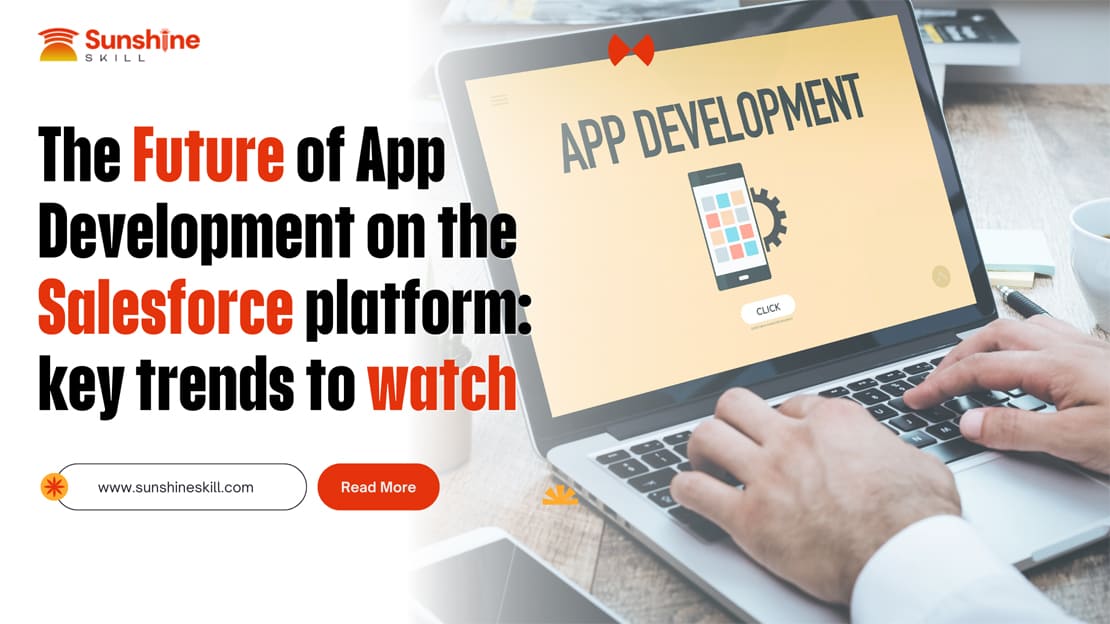Introduction
As businesses evolve, so do the demands on platforms that support and extend their digital capabilities. Salesforce, known for its customer relationship management (CRM) solutions, has become a comprehensive platform for building apps that enable businesses to interact with customers more efficiently. With new trends emerging, the future of app development on the Salesforce platform promises exciting advancements that will impact developers, admins, and end-users alike. Here, we explore the key trends shaping the future of Salesforce app development.

1. AI and Machine Learning Integration
Salesforce’s commitment to AI through Einstein, its AI-powered layer, has set the stage for a future where applications are not only smarter but more intuitive. As AI and machine learning continue to evolve, their integration within Salesforce applications will enable more personalized experiences, predictive analytics, and automation capabilities.
- Personalized Experiences: By leveraging AI, apps can provide insights tailored to each customer based on their behavior and history. This enables a deeper connection with users, improving engagement and customer satisfaction.
- Enhanced Decision-Making: Predictive analytics allow businesses to make informed decisions quickly. AI-powered features can assess data in real-time to suggest the best next steps, identify risks, and predict customer needs.
- Automation of Routine Tasks: Machine learning can analyze repetitive tasks and processes, making it easier for apps to automate workflows, which saves time and reduces errors.
2. Low-Code and No-Code Development Platforms
Salesforce’s commitment to making app development accessible to non-developers through low-code and no-code tools is redefining who can create and deploy applications. Tools like Salesforce Flow and the Salesforce Lightning App Builder allow business users to build custom applications without needing extensive coding knowledge.
- Empowering Business Users: With low-code platforms, users can create applications that address specific needs without waiting for IT or developer support. This increases agility, allowing businesses to respond faster to market changes.
- Faster Development Cycles: Low-code tools reduce development time significantly, enabling faster deployment of solutions. This trend is essential for businesses looking to keep pace with competitors.
- Cost Efficiency: Reducing the need for specialized developers can lower costs, making app development more affordable for small and medium-sized businesses.
3. Increased Focus on User Experience (UX)
As the demand for customer-centric solutions grows, so does the emphasis on user experience in app development. Salesforce app developers are increasingly focused on creating intuitive, seamless, and visually appealing interfaces.
- Responsive and Mobile-First Design: With mobile usage on the rise, apps need to perform well on all devices. Responsive, mobile-first designs ensure that users have a consistent experience, whether on a desktop or a smartphone.
- Streamlined Workflows: Ensuring that apps have simple, streamlined workflows improves productivity and reduces user frustration. A cluttered interface or complex navigation can be a significant barrier to productivity.
- Human-Centered Design: Understanding the needs and pain points of users leads to apps that are not only functional but delightful to use. Involving users in the design process is becoming a best practice for Salesforce developers.
4. Data Security and Privacy Enhancements
With increasing data privacy regulations like GDPR and CCPA, Salesforce app developers are more focused than ever on security and compliance. Data security remains a top priority, especially given the sensitive customer information often handled by Salesforce applications.
- Privacy by Design: Integrating privacy measures directly into the design and development process is becoming the standard. This approach ensures that applications comply with regulations from the ground up, protecting users’ data at every step.
- Multi-Factor Authentication (MFA) and Single Sign-On (SSO): To enhance security, Salesforce has made MFA mandatory for certain users. Many developers are now implementing advanced authentication methods, including biometrics and Single Sign-On, to improve app security.
- Encrypted Data Storage: As cyber threats evolve, developers are increasingly employing encryption techniques to ensure data security both in transit and at rest, protecting sensitive information from breaches.
5. API-Driven Development and Integration
Salesforce’s compatibility with various APIs allows for seamless integration with other tools and platforms, making API-driven development an essential trend for creating cohesive digital ecosystems.
- Interoperability Across Platforms: Businesses rely on multiple platforms for different functions. APIs enable Salesforce apps to integrate with other systems, creating unified workflows and eliminating data silos.
- Composable Architecture: Salesforce developers are embracing composable architecture, which emphasizes building apps as collections of independent components. This modular approach allows developers to reuse and adapt components across different apps.
- Data Exchange and Automation: APIs facilitate real-time data exchange between Salesforce and other applications, enabling automation across platforms and improving data accuracy.
6. Enhanced Developer Tools and Community Support
Salesforce is continuously investing in resources that empower its developer community, with initiatives like Trailhead, AppExchange, and more advanced developer tools.
- Salesforce CLI and DevOps Center: Tools like Salesforce CLI and the recently introduced DevOps Center streamline workflows for developers, helping them manage the full lifecycle of apps from development to deployment.
- Access to Learning Resources: Through Trailhead, Salesforce provides a vast library of learning modules and certifications. These resources help developers stay current with new trends and technologies in Salesforce app development.
- AppExchange Expansion: AppExchange continues to be a valuable resource for developers looking to market and distribute their apps, offering a wide audience and built-in trust within the Salesforce community.
Conclusion
The future of app development on the Salesforce platform is bright and filled with possibilities. From AI and machine learning integration to low-code tools and enhanced user experience, these trends empower developers and businesses alike. By staying informed about these advancements, developers can better harness Salesforce’s potential to deliver innovative and impactful solutions. As we look forward, those who adapt to these trends will be well-positioned to make the most of Salesforce’s powerful platform, ensuring growth and customer success.
